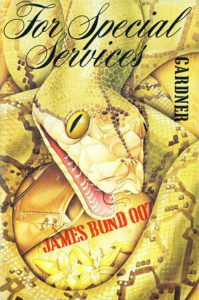Bond. James Bond. Is there a name more synonymous with spying, tuxedos, and shaken cocktails than the British secret agent? Join me as I read all of the James Bond books in 007 Case Files, encompassing Ian Fleming and beyond. For Your Eyes Only: there’s spoilers ahead.
So, the story goes that Ian Fleming took part in a clandestine operation with the Americans during the Second World War, one that would be later embellished as the basis for Casino Royale. As the behest of General William Donovan, Fleming wrote a lengthy memorandum outlining the structure of a secret service organisation that indirectly influenced the formation of the OSS and the CIA. To thank him, Donovan presented Fleming with a .38 Police Positive Colt revolver. It was inscribed with the words ‘For Special Services.’
John Gardner’s book of the same name, the second in his series of Bond continuation novels, comes with its own historical weight. After three decades of stories in print and on screen, accusations of Bond wearing a little thin dogged the novels and the films alike. Not helping matters is that Gardner chose to follow up his critically maligned Licenced Renewed with something that feels like Bond’s greatest hits.
Bond teams up with CIA operative Cedar Leiter, the daughter of his old comrade Felix, to investigate Markus Bismaquer, an ice cream merchant and art lover suspected of reviving SPECTRE (last seen in You Only Live Twice). Along the way there’s martinis, a car race, deadly animals, broken women, and an evil death ray.
“Was it possible that a new SPECTRE had risen, like some terrible mutated phoenix, to haunt them in the 1980s?”
FOR SPECIAL SERVICES opens with a tense (albeit brief) sequence in which Bond foils a plane hijacking, the first sign of the return of SPECTRE. It never feels complete somehow, skipping to the chase like a pre-credits scene in a film, perhaps because Gardner was keen to reintroduce the terrorist organisation. Indeed, much of the book feels like it is spinning its wheels (Saab wheels, of course) until the puppet master is revealed.
Gardner’s writing has been called everything from “endlessly silly” (by Colonel Sun author Kinglsey Amis) to “exceptionally bad” by Robin W. Winks. This is not the novel on which to base a counter-argument. The thin plotting is held together with scant regard for character development or tension. For all of Fleming’s faults, he invested his characters with a grounded believability. Here Gardner never gets beyond the surface, more interested in moment-to-moment action than in 007 or his supporting cast.
Which isn’t to say that there aren’t some memorable set-pieces. With the highly publicised Saab 900 Turbo making a return, and referred to by its nickname of “The Silver Beast” for the first time, Gardner delivers a terrific race against a Mustang – even if he does labour the point with pages of technical specs. Similarly, while we’ve had many encounters with animals before, Gardner’s description of thousands of deadly ants deliberately left for Bond and Cedar (“a constantly moving sea of creatures”) is both chilling and gruesome.
Another thing Gardner maintains from Fleming is his penchant for women that are ‘damaged’ in some way. Just as Honey Rider had a broken nose, Bismaquer’s wife Nena was born with only one breast: “I’m not a whole woman,” she tells Bond. “I feel deformed, and I don’t like people.” Yet Gardner tries to turn this into a strength of sorts, although some might argue it is a fetish. The revelation that she is actually Blofeld’s daughter, and the architect of all the new SPECTRE, also gives her added dimensionality. Or as Raymond Benson puts it in The James Bond Bedside Companion, “the most successful villain Gardner has created.”
“Nena Bismaquer gave Bond a smile calculated to make even the most misogynistic male buckle at the knees.”
Less successful is the finale of the plot, one in which Nena/Blofeld plans to storm the NORAD HQ and get the codes for the US satellite network. Apart from being more than reminiscent of Goldfinger, it involves the preposterous plan of brainwashing Bond to pose as a US General. However, it all comes apart because Bismaquer, revealed to be bisexual, has taken a fancy to Bond and sabotaged the hypnotism. May I remind you that this is 1982.
While we’re on the subject: exactly how old is Bond meant to be anyway? Gardner firmly establishes this book as being set in the 80s, but Bond is also said to have been an “officer in the Second World War.” As one henchmen puts it, “the Second World War was a long time ago, friend.” Later mentioned as being “just about old enough” to be Cedar’s father, Gardner’s timeline would probably put Bond somewhere between 60 and 70 years old! It’s a minor thing, but it points to some of the perfunctory editing with which Gardner has approached his subject.
FOR SPECIAL SERVICES is the kind of Bond outing one gets when you just want to go through a checklist of 007 iconography. With the introduction of Cedar Leiter, and the approval of her doting father (now with “the latest thing in artificial arms”), Gardner delivers a kind of soft reboot of his own renewal a year earlier. With another 14 books left before the end of his tenure, he certainly had time to get the formula right.
James Bond will return…in Icebreaker.






